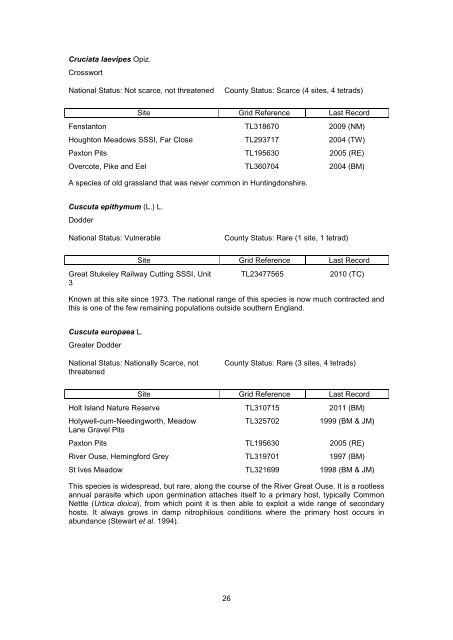Rare Plant Register for Huntingdonshire - Botanical Society of the ...
Rare Plant Register for Huntingdonshire - Botanical Society of the ...
Rare Plant Register for Huntingdonshire - Botanical Society of the ...
You also want an ePaper? Increase the reach of your titles
YUMPU automatically turns print PDFs into web optimized ePapers that Google loves.
Cruciata laevipes Opiz.<br />
Crosswort<br />
National Status: Not scarce, not threatened County Status: Scarce (4 sites, 4 tetrads)<br />
Site Grid Reference Last Record<br />
Fenstanton TL318670 2009 (NM)<br />
Houghton Meadows SSSI, Far Close TL293717 2004 (TW)<br />
Paxton Pits TL195630 2005 (RE)<br />
Overcote, Pike and Eel TL360704 2004 (BM)<br />
A species <strong>of</strong> old grassland that was never common in <strong>Huntingdonshire</strong>.<br />
Cuscuta epithymum (L.) L.<br />
Dodder<br />
National Status: Vulnerable County Status: <strong>Rare</strong> (1 site, 1 tetrad)<br />
Site Grid Reference Last Record<br />
Great Stukeley Railway Cutting SSSI, Unit<br />
3<br />
26<br />
TL23477565 2010 (TC)<br />
Known at this site since 1973. The national range <strong>of</strong> this species is now much contracted and<br />
this is one <strong>of</strong> <strong>the</strong> few remaining populations outside sou<strong>the</strong>rn England.<br />
Cuscuta europaea L.<br />
Greater Dodder<br />
National Status: Nationally Scarce, not<br />
threatened<br />
County Status: <strong>Rare</strong> (3 sites, 4 tetrads)<br />
Site Grid Reference Last Record<br />
Holt Island Nature Reserve TL310715 2011 (BM)<br />
Holywell-cum-Needingworth, Meadow<br />
Lane Gravel Pits<br />
TL325702 1999 (BM & JM)<br />
Paxton Pits TL195630 2005 (RE)<br />
River Ouse, Heming<strong>for</strong>d Grey TL319701 1997 (BM)<br />
St Ives Meadow TL321699 1998 (BM & JM)<br />
This species is widespread, but rare, along <strong>the</strong> course <strong>of</strong> <strong>the</strong> River Great Ouse. It is a rootless<br />
annual parasite which upon germination attaches itself to a primary host, typically Common<br />
Nettle (Urtica dioica), from which point it is <strong>the</strong>n able to exploit a wide range <strong>of</strong> secondary<br />
hosts. It always grows in damp nitrophilous conditions where <strong>the</strong> primary host occurs in<br />
abundance (Stewart et al. 1994).

















